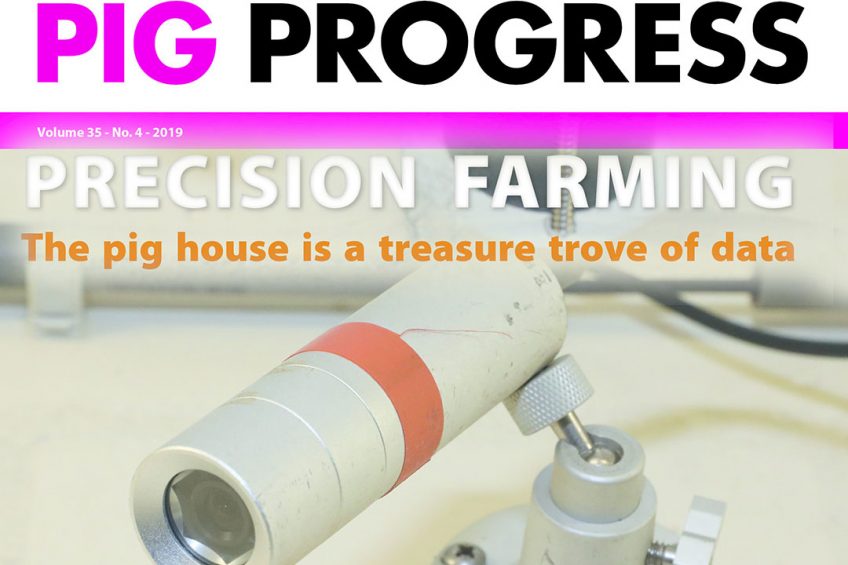Border control, Brazil and big data in Pig Progress 4

The 4th magazine issue of Pig Progress in 2019 is available. This issue we travel to Brazil, zoom in on the use of big data and there is plenty of attention for gut health and nutrition.
To start with the last topics – they jointly come back in an interesting contribution by Dr Frédéric Vangroenweghe of Elanco Animal Health. Not too long ago, the company launched a vaccine against E. coli for use in just-weaned piglets. Now how exactly does that work? The author takes the reader on a journey through the pig’s gut. Pages 32-33
Gut health and weaning age
One of the reasons why piglets could develop diarrhoea is simply because weaning came too early for them. In an article by Ghent University’s Dr Merel Postma, a link is made between weaning age and the amount of antibiotics being used on-farm. From studies from 4 countries it became clear that pigs weaned at a later age were more robust and resilient. Pages 30-31
Yeast and the sow’s gut
Flip a few more pages pages back and there is an interesting contribution by Dr David Saornil of Lallemand Animal Nutrition. Again, gut health is key but this time it’s the sow’s gut that is key rather than a piglet’s gut. This article again touches on the question – how does yeast operate once it is inside the gut, and how come that sows actually benefit from yeast addition? Pages 28-29
Plant proteins vs animal proteins
With African Swine Fever being around in many countries, pig producers tend to be very critical to all feed ingredients being used. Especially for young animal nutrition, plant proteins may have an advantage here as they are not from animal origin. In an interesting contribution by Kelly Vermeer of young animal nutrition company Joosten and Prof Hans H. Stein, Illinois University, the advantages of plant proteins are further explained. Pages 14-16

Big data help create better nutrition
A field in gut health where a lot of steps can still be made yet is in that of ‘big data’. After all, if we monitor and capture everything there is to know about young pigs, their behaviour and their digestion, so much more targeted nutrition can be supplied to the animals. That is why Trouw Nutrition embarked on an ambitious 4-year project called ‘LifeStart’… Read more on pages 24-26.
Brazil: Small steps forward
There are a few interesting years waiting for the world’s 3rd largest country when it comes to pig production: Brazil. With a new president being sympathetic to further agricultural development and loads of health challenges in the world’s number 1 pig producer, China, Brazil may just be on the verge of further growth. How did the country develop in the last decade? Correspondent Daniel Azevedo Duarte explains. Pages 10-12
Taking a look behind the scenes in Serbia
This month’s farm visit takes the reader to Serbia in the heart of Eastern Europe. At a stone’s throw from the border with Romania is Massagrar, a successful farrow-to-finish facility for 1,250 sows. Swine farming in Serbia is not always easy, but Massagrar manages to stand out. Pig Progress wondered why and found answers… Pages 20-23
Canada’s controversial food guide
Earlier this year, controversy arose from Canada where a new food guide was launched with the recommendation to shift more to plant-based proteins. Obviously, representatives from the meat industry were not amused. Correspondent Treena Hein dived into the food guide and tried to answer the question – how come this advice was being given? Pages 6-8

Columns on ‘hidden corners’ and ‘Sir Lancet’
In her column, Dr Casey Bradley touches on another publication leading to some disgruntlement – the article in The Lancet which recommended to reduce meat consumption. She has a number of interesting personal comments to make – you will find those at page 36. This month’s column by John Gadd focuses on the application of various ways to improve pig health through nutrition – he goes from probiotics to vitamin E and from yeast to the role of sows – his opinion is waiting for you to read it on page 17.
Border control
Last but not least – what is the border control about? And what’s a dog doing inside a publication called Pig Progress? You will find the answer on pages 18-19











